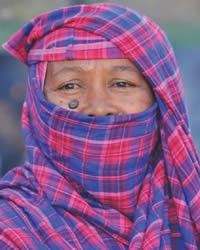Mbojo in Indonesia

Photo Source:
Copyrighted © 2026
Anonymous All rights reserved. Used with permission |
Send Joshua Project a map of this people group.
|
| People Name: | Mbojo |
| Country: | Indonesia |
| 10/40 Window: | Yes |
| Population: | 861,000 |
| World Population: | 861,000 |
| Primary Language: | Bima |
| Primary Religion: | Islam |
| Christian Adherents: | 0.06 % |
| Evangelicals: | 0.06 % |
| Scripture: | New Testament |
| Ministry Resources: | Yes |
| Jesus Film: | Yes |
| Audio Recordings: | Yes |
| People Cluster: | Bali-Sasak |
| Affinity Bloc: | Malay Peoples |
| Progress Level: |
|
Introduction / History
The Mbojo, also known as the Bima or Dompu, live in the lowlands of Bima and Dompu regencies in West Nusa Tenggara province. These two regencies are located in eastern Sumbawa island. There are also some Mbojo who live on Sangeang island. Although this area has a long coast with many bays, most of the population do not make their living from the sea. In fact, most of their communities are built about 5 km from the coast. The northern part of the island is fertile, while the southern part is barren. The Mbojo are also called the Oma ("move") because they often move from one place to another. The Bima language, sometimes called Nggahi Mbojo, has several dialects, including Bima, Bima Donggo and Sangeang.
What Are Their Lives Like?
The main livelihood of the Mbojo is farming in fields, but they also plant rice in paddies using a special irrigation system called panggawa. They are well-known horse tenders as well. Bima women are usually skilled at making plaited mats from bamboo and palm leaves, as well as weaving a famous cloth known as tembenggoli. Many Mbojo live outside their home area and at the same time many outsiders have moved into the Mbojo area. The villages of the Mbojo are called kampo or kampe and are led by a village leader called a neuhi. The village leader is assisted by highly respected village elders. The position of village leader is passed down through the generations. The Mbojo are not closed to outside influence. In the past they viewed education as a threat to their cultural traditions, but now they support it from elementary school through university. They view positively outside influences in culture and technology. Modes of transportation include carts or wagons pulled by water buffalo and horse-drawn buggies called "benhurs" after the American film Ben Hur came out. In 1969, the Nangameru area in Dompu was established as a transmigration site. As a result many Javanese and others from heavily populated areas came as transmigrants. This created many misunderstandings between the original inhabitants and the transmigrants and the social differences that developed have widened the great divide between them.
What Are Their Beliefs?
Although most Mbojo are devout Muslims, they still believe in spirits and practice forms of animism, even still visiting healers - who are numerous in the area. They ask for advice and help from the healers, especially during times of difficulty and crisis. The Mbojo are afraid of local gods like Batara Gangga (chief of the gods), Batara Guru, Idadari Sakti and Jeneng, as well as other spirit types called Bake and Jin, which live in trees and high mountains. They believe these spirits can bring sickness and disasters. They also believe in sacred trees in Kalate and Murmas, where the god Batara and the gods of Rinjani mountain dwell. The beliefs of the ancestors are called pare no bongi by the Mbojo - belief in the spirits of the ancestors. In the 1930s, hundreds of Mbojo in the mountain areas around Dompu heard the gospel and received it. Today there are four villages in the mountains with a 'Christian' population of 90 percent, but they do not fully understand the gospel. They are very isolated and poor.
What Are Their Needs?
The Mbojo need agricultural training and farming equipment. Helping increase the people's awareness of the benefits they could find in the ocean would help improve their economic state.
Prayer Points
Pray for the Lord to send dreams of the risen Christ to Mbojo family leaders and imams.
Pray for the Lord to prepare and thrust out workers to this Muslim community.
Pray for Mbojo leaders to understand that only by the blood of a sin-free Savior can they be in fellowship with God.